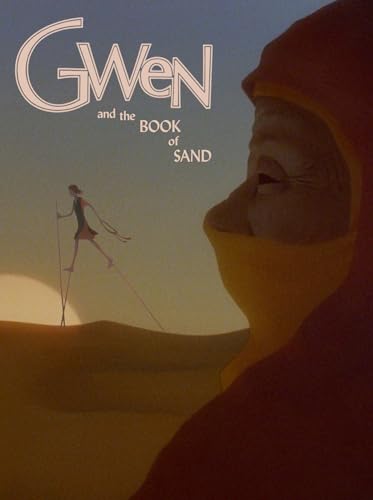Gwen Et Le Livre De Sable
366 Weird Movies may earn commissions from purchases made through product links.
DIRECTED BY: Jean-François Laguionie
FEATURING: Voices of Michel Robin, Lorella DiCicco, Armand Babel, Raymond Jourdan, Jacques Ruisseau
PLOT: Sometime “After the gods have left…”, what remains is a desert landscape in which a few animals and nomads make their home; the only danger being the Makou, something that drops objects of various size onto the desert floor, forcing the nomads to live underground. Gwen, an orphan, falls in love with a strange boy, Nokmoon, who is taken away one night by the Makou. She and Roseline (a 173 year old woman) set off on a journey to retrieve him; in doing so, they encounter a mysterious cult.

COMMENTS: The post-apocalyptic tale is a genre of its own, but when you take post-apocalypse and desert and put them together, you get The Road Warrior. It’s practically the template followed by its own sequels and countless homages/ripoffs. And when it comes to non-apocalyptic sci-fi/fantasy, the template is Dune. These stories are usually heavily plot-driven, with a relentless forward momentum.
Gwen is desert post-apocalypse in a poetic mode. The title might make one surmise that the title character will undergo a series of adventures and challenges for the next hour or so, but it’s not so. The movie is gentler than that. It’s paced leisurely; there is a plot, but it drives lightly. Instead, the film focuses on visuals: characters walking across the sands on stilts, landscapes littered with objects such as oversized utensils and eyeglasses, close-ups of the pincipals. And it’s all the more striking for being animated with a gouache paint palette, which softens things, giving the impression of a dream. (One visual reference that I twigged was Henri Rousseau’s “The Sleeping Gypsy.”)
Gwen is about mood and atmosphere: the surreality of the landscape, how the nomads live in this world, how they hunt, how they travel. There’s little explanation of how this desert came to exist, other than the oblique “the gods have left,” or of the Makou. And that’s to the film’s advantage, especially as things get more surreal and the introduction of the Makou Cult (which includes pointed satire of religion). Although there are what could be referred to as “antagonists,” there’s no outright villain, as there would be in a more standard treatment. The music of Pierre Alrand, a longtime collaborator of Laguione’s, adds to the moody atmosphere.
Fantastic Planet, another French animation with a similar mood and adult approach, is Gwen‘s closest relative. Planet, however, is much more brutal in approach. Gwen is made for adults, but it’s family-friendly—although it’s probably way too slow and not antic enough for young children (although the visuals may attract them). Older kids could get more out of it, though again it’s paced much slower than current animated films. Fans of Hayao Miyazaki, and especially of Nausicaa of the Valley of the Wind, might also get into the film’s rhythm and mood.
Gwen‘s first ever U.S. release on 4K and Blu-ray comes from Deaf Crocodile, in a limited or standard edition. The movie has a commentary by Samm Deighan, along with an interview with director Laguionie by Dennis Bartok and an intriguing video essay by Dr. Will Dodson and Ryan Verrill. The Limited Edition includes a 60 page booklet with essays by Laguionie, film historian Jennifer Barker, and critic/DC house writer Walter Chaw, as well as a slipcase with new art by Beth Morris.

(This movie was noimated for review by Russa03, who said it was “a surrealist, post-apocalypse animation and it’s beautiful to boot.” Suggest a weird movie of your own here.)





![Freckled Max And The Spooks [Blu-ray]](https://m.media-amazon.com/images/I/51EUW7jXJxL._SL500_.jpg)



![The Cathedral Of New Emotions [Blu-ray]](https://m.media-amazon.com/images/I/41unDZMAUNL._SL500_.jpg)

 The comedy is good, including moves named for films Lee appeared in and talking skeletons. At times it’s naughty: a running gag involving Lee’s rumored sexual prowess and the Underworld King’s wives attempting to find that out firsthand; a joke involving nunchucks and “Bruce Lee’s Third Leg,” which was snatched subsequently for other kung-fu comedies. And just the idea of bringing together Popeye, Emmanuelle, 007 and others is brilliant, especially since such a thing wouldn’t even be possible in today’s corporate climate unless it were a no-budget ultra-underground project that maybe 30 people would even be aware of existing.
The comedy is good, including moves named for films Lee appeared in and talking skeletons. At times it’s naughty: a running gag involving Lee’s rumored sexual prowess and the Underworld King’s wives attempting to find that out firsthand; a joke involving nunchucks and “Bruce Lee’s Third Leg,” which was snatched subsequently for other kung-fu comedies. And just the idea of bringing together Popeye, Emmanuelle, 007 and others is brilliant, especially since such a thing wouldn’t even be possible in today’s corporate climate unless it were a no-budget ultra-underground project that maybe 30 people would even be aware of existing.
![The Game Of Clones: Bruceploitation Collection - Volume 1 (7-Disc Special Edition) [Blu-ray]](https://m.media-amazon.com/images/I/51vhC5R6uJL._SL500_.jpg)


